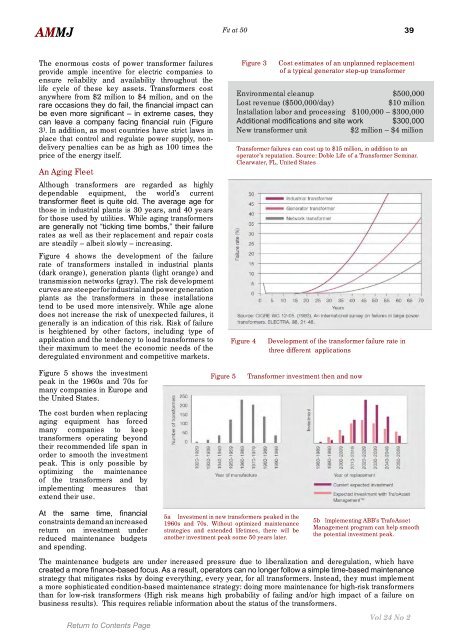April - Library
April - Library
April - Library
You also want an ePaper? Increase the reach of your titles
YUMPU automatically turns print PDFs into web optimized ePapers that Google loves.
AMMJ Fit at 50 39<br />
The enormous costs of power transformer failures<br />
provide ample incentive for electric companies to<br />
ensure reliability and availability throughout the<br />
life cycle of these key assets. Transformers cost<br />
anywhere from $2 million to $4 million, and on the<br />
rare occasions they do fail, the financial impact can<br />
be even more significant – in extreme cases, they<br />
can leave a company facing financial ruin (Figure<br />
3 ). In addition, as most countries have strict laws in<br />
place that control and regulate power supply, nondelivery<br />
penalties can be as high as 100 times the<br />
price of the energy itself.<br />
An Aging Fleet<br />
Although transformers are regarded as highly<br />
dependable equipment, the world’s current<br />
transformer fleet is quite old. The average age for<br />
those in industrial plants is 30 years, and 40 years<br />
for those used by utilities. While aging transformers<br />
are generally not “ticking time bombs,” their failure<br />
rates as well as their replacement and repair costs<br />
are steadily – albeit slowly – increasing.<br />
Figure 4 shows the development of the failure<br />
rate of transformers installed in industrial plants<br />
(dark orange), generation plants (light orange) and<br />
transmission networks (gray). The risk development<br />
curves are steeper for industrial and power generation<br />
plants as the transformers in these installations<br />
tend to be used more intensively. While age alone<br />
does not increase the risk of unexpected failures, it<br />
generally is an indication of this risk. Risk of failure<br />
is heightened by other factors, including type of<br />
application and the tendency to load transformers to<br />
their maximum to meet the economic needs of the<br />
deregulated environment and competitive markets.<br />
Figure 5 shows the investment<br />
peak in the 1960s and 70s for<br />
many companies in Europe and<br />
the United States.<br />
The cost burden when replacing<br />
aging equipment has forced<br />
many companies to keep<br />
transformers operating beyond<br />
their recommended life span in<br />
order to smooth the investment<br />
peak. This is only possible by<br />
optimizing the maintenance<br />
of the transformers and by<br />
implementing measures that<br />
extend their use.<br />
At the same time, financial<br />
constraints demand an increased<br />
return on investment under<br />
reduced maintenance budgets<br />
and spending.<br />
Figure 3 Cost estimates of an unplanned replacement<br />
of a typical generator step-up transformer<br />
Environmental cleanup $500,000<br />
Lost revenue ($500,000/day) $10 million<br />
Installation labor and processing $100,000 – $300,000<br />
Additional modifications and site work $300,000<br />
New transformer unit $2 million – $4 million<br />
Transformer failures can cost up to $15 million, in addition to an<br />
operator’s reputation. Source: Doble Life of a Transformer Seminar.<br />
Clearwater, FL, United States<br />
Figure 4 Development of the transformer failure rate in<br />
three different applications<br />
Figure 5 Transformer investment then and now<br />
5a Investment in new transformers peaked in the<br />
1960s and 70s. Without optimized maintenance<br />
strategies and extended lifetimes, there will be<br />
another investment peak some 50 years later.<br />
5b Implementing ABB’s TrafoAsset<br />
Management program can help smooth<br />
the potential investment peak.<br />
The maintenance budgets are under increased pressure due to liberalization and deregulation, which have<br />
created a more finance-based focus. As a result, operators can no longer follow a simple time-based maintenance<br />
strategy that mitigates risks by doing everything, every year, for all transformers. Instead, they must implement<br />
a more sophisticated condition-based maintenance strategy: doing more maintenance for high-risk transformers<br />
than for low-risk transformers (High risk means high probability of failing and/or high impact of a failure on<br />
business results). This requires reliable information about the status of the transformers.<br />
Vol 24 No 2
















